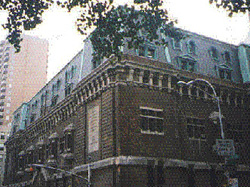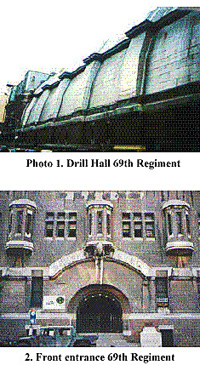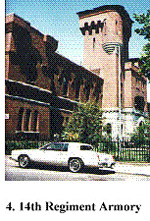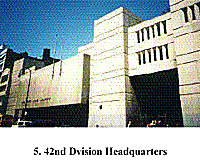 In 1877 the United States War Department authorized the construction of fortified bases for local militia in many of the nation's cities. The armory, as such a building was to be known, was a uniquely American concept, and became an important part of the urban landscape.
In 1877 the United States War Department authorized the construction of fortified bases for local militia in many of the nation's cities. The armory, as such a building was to be known, was a uniquely American concept, and became an important part of the urban landscape.
3. 69th Regiment side view. Note the two-story Mansard roof, an architectural feature brought from France which was extremely popular at the time.
For many city-dwellers, it would become the only military structure they would ever see.
In this article we will look at several of the armories built for the National Guard within the confines of present day New York City.
Background
Prior to the era of the armories, local militia units met for drills and instruction in a variety of spaces, both indoors and out. One example of an early headquarters that still survives is the State Arsenal in Central Park, built in 1847, which is currently utilized as the executive offices for the City's Department of Parks and Recreation. In post-Civil War New York, as in other major urban centers, increasing concern over the possibility of widespread civil unrest caused government officials to consider the construction of larger, more secure headquarters which could afford some protection in times of rampant rioting.
Such fears were not exactly unrealistic at the time, for widespread outbreaks such as the Civil War Draft Riots gave the middle class real cause for alarm. Local Armory Boards were organized in the cities of New York and Brooklyn, which invested millions of dollars in the construction of these structures, and hired noted civilian architects to design them.
Such was the concern over the possibility of anarchy amongst the City's wealthy citizens that, when funds ran out for the 7th Regiment Armory, the first of the great halls to be built in New York, large corporations and wealthy families such as the Astors and Vanderbilts contributed $589,000 of their own money to complete it. In time, some 29 armories were constructed.
The Layout of an Armory
All armories were composed of two separate, but interconnected, spaces. The first was a large drill hall, typically with a high vaulted ceiling, which would allow hundreds of militiamen to practice their maneuvers indoors without interference from supporting pillars. The technology which allowed for such large enclosed spaces was borrowed from another important 19th Century institution: the railroad station. In some of the later armories, these halls had entrances that could accommodate large vehicles or cavalry.
 Photo 1 (at right) shows a side view of the drill hall of the 69th Regiment, headquartered at Lexington Avenue between 25 and 26 Streets, which takes up the better part of a city block. Constructed in 1906, this armory is still in active service.
Photo 1 (at right) shows a side view of the drill hall of the 69th Regiment, headquartered at Lexington Avenue between 25 and 26 Streets, which takes up the better part of a city block. Constructed in 1906, this armory is still in active service.
Attached to the hall was always a two to four-floor headquarters for the militia unit, comprising offices, classrooms, dining facilities and other support operations. Photo 2 shows the front entrance to the 69th Regiment. Note the semi-circular archway, a standard part of the front entrances of most buildings constructed in the Romanesque style, which flourished around the turn of the century.
Despite their thoroughly utilitarian purpose, many New York armories were quite ornate, handsome structures designed by leading architects of their day. One reason for this was the composition of the local militia units themselves, whose members were often drawn from the growing urban middle classes. In fact, Charles Clinton, designer of the 7th Regiment armory, was himself a member of that very group. The late 19th and early 20th Centuries were a glorious time for municipal architecture, and the armories were part of the trend.
 Photo 4 shows a side view of Brooklyn's 14th Regiment Armory, constructedin 1895. Note the impressive tower. Eventually these structures were built in all five counties comprising the modern city of New York, whichbecame unified in 1898. Brooklyn had a substantial number, chiefly located in its older, more developed sections.
Photo 4 shows a side view of Brooklyn's 14th Regiment Armory, constructedin 1895. Note the impressive tower. Eventually these structures were built in all five counties comprising the modern city of New York, whichbecame unified in 1898. Brooklyn had a substantial number, chiefly located in its older, more developed sections.
Armories Today
After World War II, many armories were demolished or sold. Currently, only 10 remain as active headquarters for various units of the National Guard within the City limits. Some of the others, such as the previously-mentioned 14th Regiment, were sold to the City government, which used the vast indoor spaces for various purposes. In this case, the building was turned into a giant shelter for homeless people, a purpose which many of the armories currently serve. Many armories, both decommissioned and in active service, are periodically rented out for cultural activities such as art exhibits.
 The most recent armory constructed in the city was a replacement of the 42 Division's headquarters on 14th Street, built in 1971. As Photo 5 (at right) clearly shows, this modern creation was no match for the earlier examples of the genre.
The most recent armory constructed in the city was a replacement of the 42 Division's headquarters on 14th Street, built in 1971. As Photo 5 (at right) clearly shows, this modern creation was no match for the earlier examples of the genre.
But perhaps the most creative use for one of these impressive structures was the one devised by the American Broadcasting Company, which purchased the First Battery Armory on Central Park West for use as a television studio.
References
Edwin G. Burrows and Mike Wallace, Gotham: A History Of New York City To 1898 New York: Oxford University Press, 1999.
Elliot Willensky and Norval White, The AIA Guide to New York. New York: Harcourt, Brace and Co., 1988.
Back to Cry Havoc #29 Table of Contents
Back to Cry Havoc List of Issues
Back to MagWeb Master Magazine List
© Copyright 2000 by David W. Tschanz.
This article appears in MagWeb (Magazine Web) on the Internet World Wide Web. Other military history articles and gaming articles are available at http://www.magweb.com